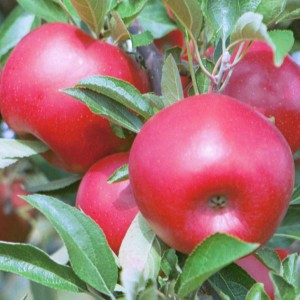GENEVA, N.Y. — After years of development and consumer testing as “NY1” and “NY2” Cornell University and New York Apple Growers have given the hottest new apples in the Empire State names worthy of their unique assets: SnapDragon and RubyFrost.
The names were revealed recently by Jeff Crist, vice chairman of the NYAG board of directors, at the annual Fruit Field Days at the New York State Agricultural Experiment Station in Geneva, where Cornell breeder and horticulture professor Susan Brown developed the varieties.
“SnapDragon is a great name for this apple because consumers found its crispy texture and sweet flavor so appealing,” said Mark Russell, an apple grower and NYAG member.
Taste
SnapDragon, formerly NY1, gets its juicy crispness from its Honeycrisp parent, and it has a spicy-sweet flavor that was a big hit with taste testers. Russell anticipates it will be a popular apple for snacking, especially for children.

Brown said she recognized its promise and fast-tracked it for commercialization.
“I remember my very first bite of SnapDragon. The taste, the crispness and the juiciness impressed us,” Brown said. “Retailers will appreciate its other qualities as well, because although SnapDragon’s harvest window starts relatively early — in late September — its long storage and shelf life means retailers may be able to offer it with consistent quality for a longer time than Honeycrisp.”
RubyFrost, formerly NY2, which ripens later in the fall and stores well, will provide a boost of vitamin C well into winter. Brown expects it will be popular with fans of Empire and Granny Smith.
“I think juicy and refreshing when I eat a RubyFrost,” Russell said. “It’s a fascinating apple, with a beautiful skin and a nice sugar-acid balance, but to me the crisp juiciness is rewarding every time.”
The two varieties have been a decade in the making, and how they’ve gone to market is a first for the Cornell apple-breeding program and the New York apple industry.

Historically, public universities developed new apple breeds and released them to the industry freely. But in 1980, the Bayh-Dole Act gave universities the ability to retain the intellectual property rights for their research, with limited plant-based royalties.
In May 2010, Cornell forged a partnership for a managed release with NYAG, a new industry group, to establish an exclusive licensing agreement in North America for the two apple varieties.
Agreement
Growers pay royalties on trees purchased, acreage planted and fruit produced, and the income is used to market the new varieties and support Cornell’s apple-breeding program.
The first trees were planted in farmers’ orchards in 2011, and now 400 acres are growing across the state. According to NYAG, the still-young trees will produce a limited crop this year, but intrepid consumers can search out SnapDragon and RubyFrost at select NYAG farm stands across the state. By 2015, the varieties will be vying for space in grocery stores among the Empires, Galas and Honeycrisps.
Qualities
Greater quality, better storage, and disease and insect resistance have long been the goals of Cornell’s apple breeding program.
In addition to SnapDragon and RubyFrost, Cornell has released 66 apple varieties since the late 1890s, including the popular Cortland, Macoun, Empire and Jonagold. Brown herself has brought consumers the highly popular Fortune and Autumncrisp varieties, as well as 10 sweet varieties and one tart cherry variety.











